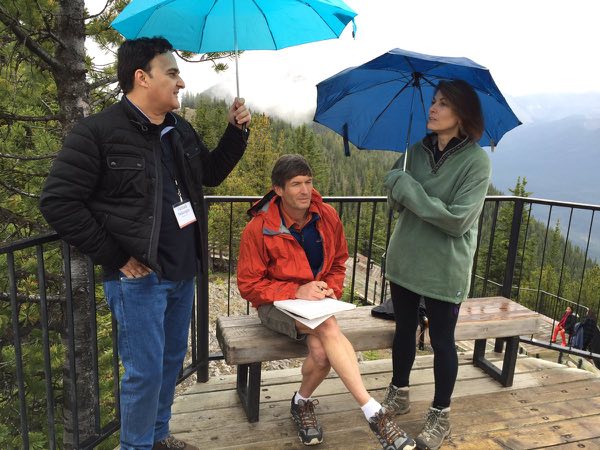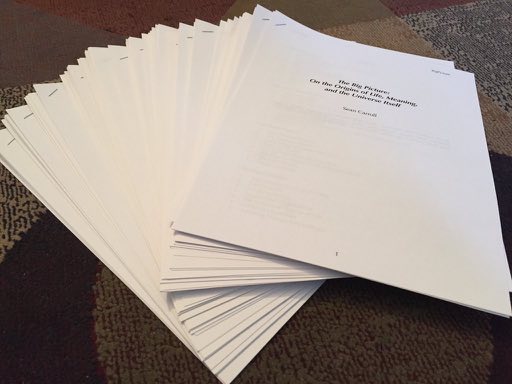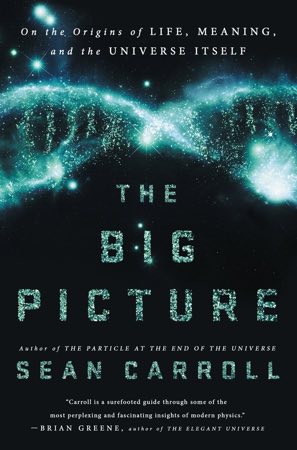For many people, the phenomenon of consciousness is the best evidence we have that there must be something important missing in our basic physical description of the world. According to this worry, a bunch of atoms and particles, mindlessly obeying the laws of physics, can’t actually experience the way a conscious creature does. There’s no such thing as “what it is to be like” a collection of purely physical atoms; it would lack qualia, the irreducibly subjective components of our experience of the world. One argument for this conclusion is that we can conceive of collections of atoms that behave physically in exactly the same way as ordinary humans, but don’t have those inner experiences — philosophical zombies. (If you think about it carefully, I would claim, you would realize that zombies are harder to conceive of than you might originally have guessed — but that’s an argument for another time.)
The folks who find this line of reasoning compelling are not necessarily traditional Cartesian dualists who think that there is an immaterial soul distinct from the body. On the contrary, they often appreciate the arguments against “substance dualism,” and have a high degree of respect for the laws of physics (which don’t seem to need or provide evidence for any non-physical influences on our atoms). But still, they insist, there’s no way to just throw a bunch of mindless physical matter together and expect it to experience true consciousness.
People who want to dance this tricky two-step — respect for the laws of physics, but an insistence that consciousness can’t reduce to the physical — are forced to face up to a certain problem, which we might call the causal box argument. It goes like this. (Feel free to replace “physical particles” with “quantum fields” if you want to be fastidious.)
- Consciousness cannot be accounted for by physical particles obeying mindless equations.
- Human beings seem to be made up — even if not exclusively — of physical particles.
- To the best of our knowledge, those particles obey mindless equations, without exception.
- Therefore, consciousness does not exist.
Nobody actually believes this argument, let us hasten to add — they typically just deny one of the premises.
But there is a tiny sliver of wiggle room that might allow us to salvage something special about consciousness without giving up on the laws of physics — the concept of downward causation. Here we’re invoking the idea that there are different levels at which we can describe reality, as I discussed in The Big Picture at great length. We say that “higher” (more coarse-grained) levels are emergent, but that word means different things to different people. So-called “weak” emergence just says the obvious thing, that higher-level notions like the fluidity or solidity of a material substance emerge out of the properties of its microscopic constituents. In principle, if not in practice, the microscopic description is absolutely complete and comprehensive. A “strong” form of emergence would suggest that something truly new comes into being at the higher levels, something that just isn’t there in the microscopic description.
Downward causation is one manifestation of this strong-emergentist attitude. It’s the idea that what happens at lower levels can be directly influenced (causally acted upon) by what is happening at the higher levels. The idea, in other words, that you can’t really understand the microscopic behavior without knowing something about the macroscopic.
There is no reason to think that anything like downward causation really happens in the world, at least not down to the level of particles and forces. While I was writing The Big Picture, I grumbled on Twitter about how people kept talking about it but how I didn’t want to discuss it in the book; naturally, I was hectored into writing something about it.
But you can see why the concept of downward causation might be attractive to someone who doesn’t think that consciousness can be accounted for by the fields and equations of the Core Theory. Sure, the idea would be, maybe electrons and nuclei act according to the laws of physics, but those laws need to include feedback from higher levels onto that microscopic behavior — including whether or not those particles are part of a conscious creature. In that way, consciousness can play a decisive, causal role in the universe, without actually violating any physical laws.
One person who thinks that way is John Searle, the extremely distinguished philosopher from Berkeley (and originator of the Chinese Room argument). I recently received an email from Henrik Røed Sherling, who took a class with Searle and came across this very issue. He sent me this email, which he was kind enough to allow me to reproduce here:
Hi Professor Carroll,
I read your book and was at the same time awestruck and angered, because I thought your entire section on the mind was both well-written and awfully wrong — until I started thinking about it, that is. Now I genuinely don’t know what to think anymore, but I’m trying to work through it by writing a paper on the topic.
I took Philosophy of Mind with John Searle last semester at UC Berkeley. He convinced me of a lot of ideas of which your book has now disabused me. But despite your occasionally effective jabs at Searle, you never explicitly refute his own theory of the mind, Biological Naturalism. I want to do that, using an argument from your book, but I first need to make sure that I properly understand it.
Searle says this of consciousness: it is caused by neuronal processes and realized in neuronal systems, but is not ontologically reducible to these; consciousness is not just a word we have for something else that is more fundamental. He uses the following analogy to visualize his description: consciousness is to the mind like fluidity is to water. It’s a higher-level feature caused by lower-level features and realized in a system of said lower-level features. Of course, for his version of consciousness to escape the charge of epiphenomenalism, he needs the higher-level feature in this analogy to act causally on the lower-level features — he needs downward causation. In typical fashion he says that “no one in their right mind” can say that solidity does not act causally when a hammer strikes a nail, but it appears to me that this is what you are saying.
So to my questions. Is it right to say that your argument against the existence of downward causation boils down to the incompatible vocabularies of lower-level and higher-level theories? I.e. that there is no such thing as a gluon in Fluid Dynamics, nor anything such as a fluid in the Standard Model, so a cause in one theory cannot have an effect in the other simply because causes and effects are different things in the different theories; gluons don’t affect fluidity, temperaturs and pressures do; fluids don’t affect gluons, quarks and fields do. If I have understood you right, then there couldn’t be any upward causation either. In which case Searle’s theory is not only epiphenomenal, it’s plain inaccurate from the get-go; he wants consciousness to both be a higher-level feature of neuronal processes and to be caused by them. Did I get this right?
Best regards,
Henrik Røed Sherling
Here was my reply:
Dear Henrik–
Thanks for writing. Genuinely not knowing what to think is always an acceptable stance!
I think your summary of my views are pretty accurate. As I say on p. 375, poetic naturalists tend not to be impressed by downward causation, but not by upward causation either! At least, not if your theory of each individual level is complete and consistent.
Part of the issue is, as often happens, an inconsistent use of a natural-language word, in this case “cause.” The kinds of dynamical, explain-this-occurrence causes that we’re talking about here are a different beast than inter-level implications (that one might be tempted to sloppily refer to as “causes”). Features of a lower level, like conservation of energy, can certainly imply or entail features of higher-level descriptions; and indeed the converse is also possible. But saying that such implications are “causes” is to mean something completely different than when we say “swinging my elbow caused the glass of wine to fall to the floor.”
So, I like to think I’m in my right mind, and I’m happy to admit that solidity acts causally when a hammer strikes a nail. But I don’t describe that nail as a collection of particles obeying the Core Theory *and* additionally as a solid object that a hammer can hit; we should use one language or the other. At the level of elementary particles, there’s no such concept as “solidity,” and it doesn’t act causally.
To be perfectly careful — all this is how we currently see things according to modern physics. An electron responds to the other fields precisely at its location, in quantitatively well-understood ways that make no reference to whether it’s in a nail, in a brain, or in interstellar space. We can of course imagine that this understanding is wrong, and that future investigations will reveal the electron really does care about those things. That would be the greatest discovery in physics since quantum mechanics itself, perhaps of all time; but I’m not holding my breath.
I really do think that enormous confusion is caused in many areas — not just consciousness, but free will and even more purely physical phenomena — by the simple mistake of starting sentences in one language or layer of description (“I thought about summoning up the will power to resist that extra slice of pizza…”) but then ending them in a completely different vocabulary (“… but my atoms obeyed the laws of the Standard Model, so what could I do?”) The dynamical rules of the Core Theory aren’t just vague suggestions; they are absolutely precise statements about how the quantum fields making up you and me behave under any circumstances (within the “everyday life” domain of validity). And those rules say that the behavior of, say, an electron is determined by the local values of other quantum fields at the position of the electron — and by nothing else. (That’s “locality” or “microcausality” in quantum field theory.) In particular, as long as the quantum fields at the precise position of the electron are the same, the larger context in which it is embedded is utterly irrelevant.
It’s possible that the real world is different, and there is such inter-level feedback. That’s an experimentally testable question! As I mentioned to Henrik, it would be the greatest scientific discovery of our lifetimes. And there’s basically no evidence that it’s true. But it’s possible.
So I don’t think downward causation is of any help to attempts to free the phenomenon of consciousness from arising in a completely conventional way from the collective behavior of microscopic physical constituents of matter. We’re allowed to talk about consciousness as a real, causally efficacious phenomenon — as long as we stick to the appropriate human-scale level of description. But electrons get along just fine without it.





